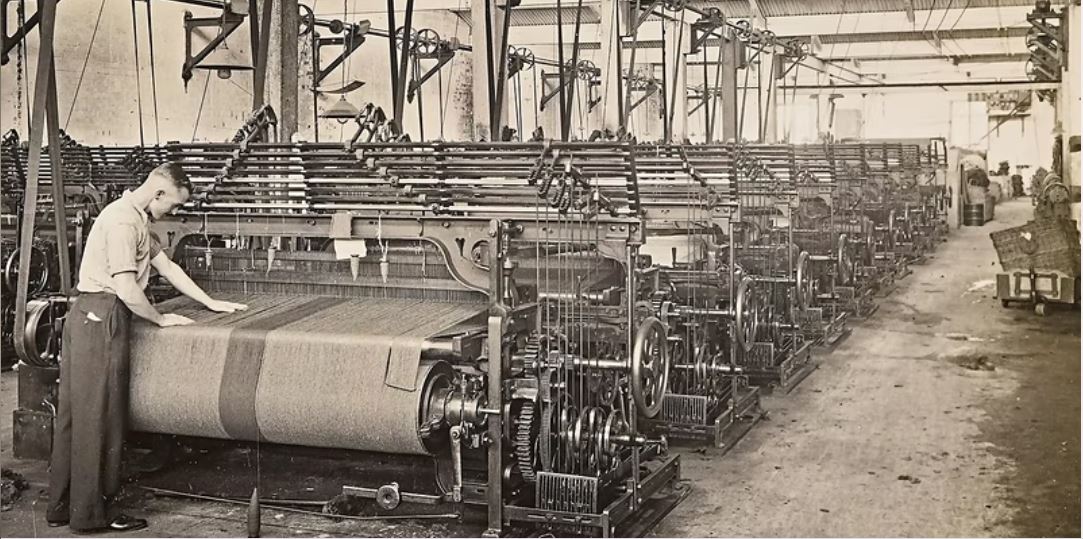About the Project
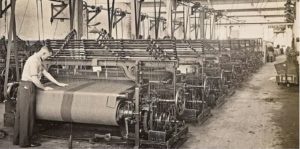
Origin Threads explores the weaving together of geography, geology, people, animals and events that came together to enable Ipswich to become woollen textile manufacturing hub for Queensland. A series of video four short video clips tells the story of the beginnings of Queensland’s woollen textile industry which ran from 1877 to 1994.
Introducing Ipswich’s first Woollen Mill
This first episode in the series introduces the mill, and how its opening was a pivotal event for the town.
Coaxing the mill into being
This provides background on the Queensland Colony textile manufacturing incentives
Setting up the board (5:52)
This episode tells of the prospectus, the provisional board and first board of directors
The mill making Ipswich
This final episode tells of the dreams and desires for the mill as it was forming and when it opened.
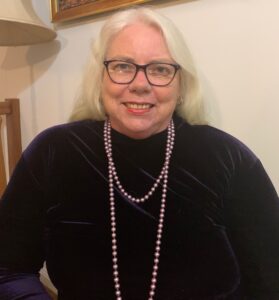
Dr Janis Hanley
Resident Adjunct, Griffith University
Several threads weave their way through Janis’s research and creative work. Her focus is on the margins, the marginalised, and the forgotten, working with place, heritage, and story and what they create.
New materialism provides Janis with the tools for visualising and gaining insights through considering intra-actions between places, humans, non-humans and other matter. The methods Janis uses are anchored in ethnography, gathering data through interviews, walking sites, objects and photographs, auto-ethnography, and other ways to elicit memories and capture the present. Her approach to analysis attempts to map the patterns of diffraction, and flows of affect. Her outputs included articles, presentations, exhibitions, and digital stories.
Janis’s PHD was conferred in July 2022, in her field of critical heritage. Her doctoral research focused on Queensland’s woollen textile industry, based in Ipswich, the last mill closing in 1994. Janis conducted twenty-four ethnographic interviews with former workers. Her Information Technology background means Janis has a has keen interest in digital media as a learning tool. Her Arts and Media masters research focused on a digital storytelling program at a small museum, for high school history students.
Janis’s current research projects: Chinese market Gardens of Croydon and Stephens, including their connections with First Nations people; Ipswich Threads – an exhibition at the Heritage listed mill and creation of an online woollen mill hub. Onsite interpretive signage and sound-trail for the Croydon Chinese Temple and settlement site.
Four short video clips were compiled to tell the story of the establishment of Queensland’s first woollen mill, the Queensland Woollen Manufacturing Company situated in Ipswich. The mill opened in 1877, the first of three mills for Ipswich. the Ipswich Woollen Company coming online in 1911, and the Morris Woollen mill at Redbank, in 1932. the first two mills merged in 1868, but this was short lived, finally closing in 1971. Morris mill kept on, but eventually sold to overseas interests, finally closing its doors in 1994.
The video clips tell of the establishment of Queenslands’ woollen industry, when the colony was in its early days, and explores the desires that drove getting the operations off the ground. The clips cover the opening day , parliamentary discussions on incentives , the establishment of the board, and community expectations around the mill.
For further information about the lead up to the mil establishment, view the Mill background tabs.
Introducing Queensland’s first woollen mill
This first episode in the series introduces the mill, and how its opening was a ‘red letter day’ not only for Ipswich, but also for the new colony of Queensland.
Coaxing the mill into being
This clip provides background on the Queensland Colony’s textile manufacturing incentives, and the parliamentary discussions. Again, these were significant decisions for the colony. Industry was needed to attract new immigrants to Queensland.
Setting up the board
This episode tells of the prospectus, the provisional board and first board of directors, the main players, and the extraordinary efforts they ent to in getting the mill up and running.
The mill making Ipswich
This final episode tells of the dreams and desires for the mill as it was forming and when it opened.
The early context of Ipswich’s woollen textile industry
Geography, Geology and the closing of a penal colony
Rivers carve their way
connecting mountains to sea, drawing
glimpses of what lies beneath
In 1839, the Moreton Bay penal colony was closing its doors. New prospects were emerging. Desires were being aroused. The mining and processing of Limestone found along the Bremer River had finished up. Allan Cunningham had long been and gone, raising awareness of the potential offered by the Darling downs pastures – and a gap in the Great Dividing Range, connecting the Downs to Moreton Bay and the export opportunities beyond.
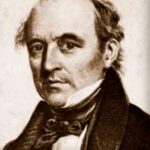
“You may discover another Australia, but you will never discover another Darling Downs.”
(Cunningham in Morgan 1902, P.16)
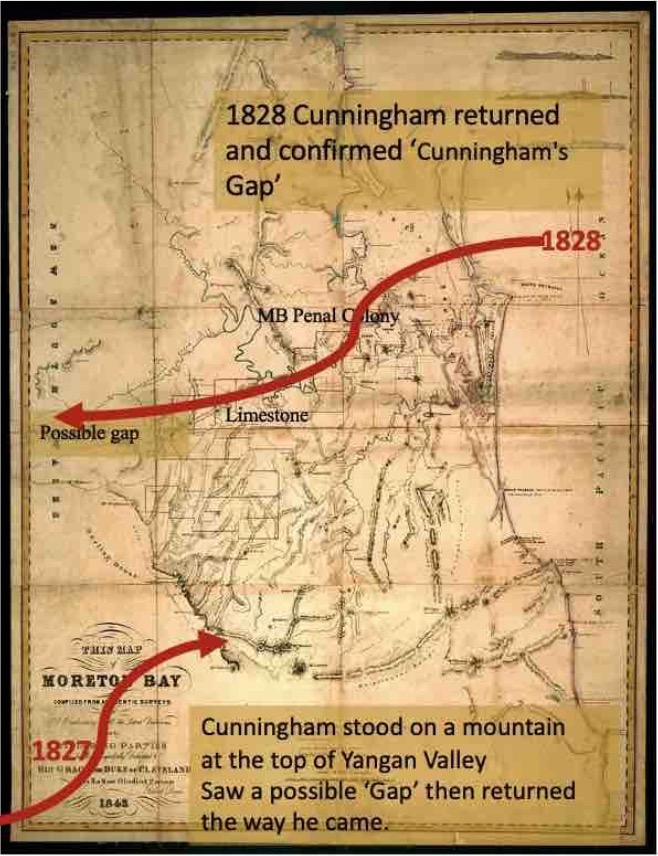
Dixon’s 1842 survey map provides a perspective of the Darling Downs, Limestone (former name of Ipswich), and the Moreton Bay colony.
The richness of the Darling Downs was a lure that took over a decade to be triggered, but finally it was time. In the 1840s, the pastoralists came … the Leslie brothers, Arthur Hodgson, John “Tinker” Campbell and many that followed.
The dividing range was both a geographical boundary and a political one. While the penal colony was still located in Brisbane, no one was allowed within 50 miles – from the bay to the base of the Great Dividing Range was ‘out of bounds’. Cunningham’s Gap too, was itself precarious, and a danger to drays, but over time new ways were found.
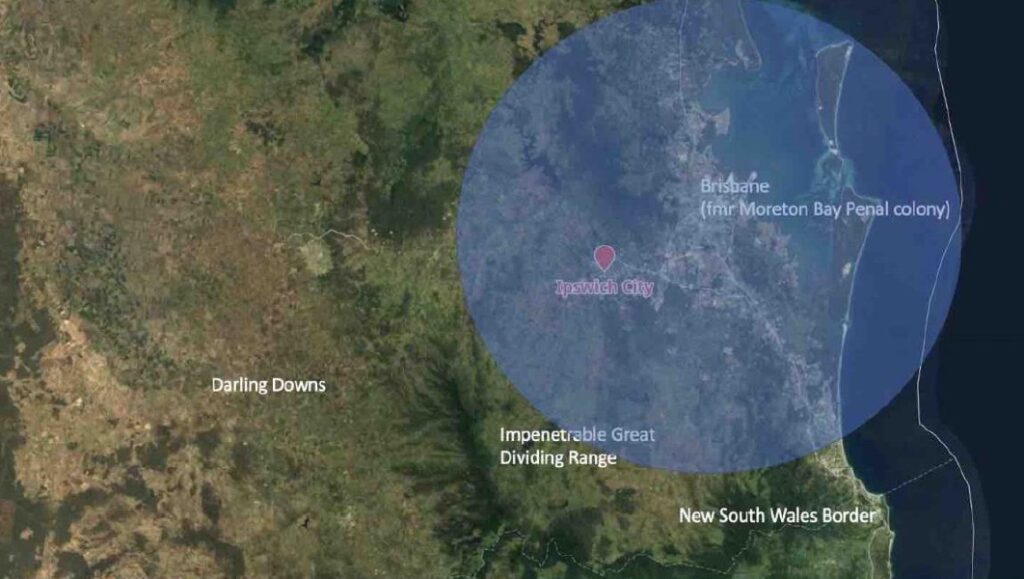
According to descendant and biographer, Richard Thorn, the Thorns saw an opportunity with the closure of Moreton Bay penal colony.
George Thorn, a 33-year-old, was regimental officer from England, and based in Sydney. He took a pay cut for a job to move north from Sydney, overseeing at the old Limestone station, overseeing the colony’s farms. His hope was to be in prime position as the colony opened. He and his 18-year-old wife, Jane and new baby travelled to Brisbane, then took a punt up the Brisbane River into the Bremer and their isolated cottage near the river. They did not stay isolated for long. While Thorn was still on the government payroll, he got permission to use his farm sheds for accommodation and a store. And the squatters came, on their way to Moreton Bay, enjoying the hospitality of the Thorns.
The closure of the penal colony in 1842, put the Thorns on the spot for the first land sales, taking their pick of the lots at Limestone, hastily renamed Ipswich for the sales. The Thorn’s savings from their side business accommodating squatters gave them the capital to build a state-of-the-art pub in the main street of Ipswich.
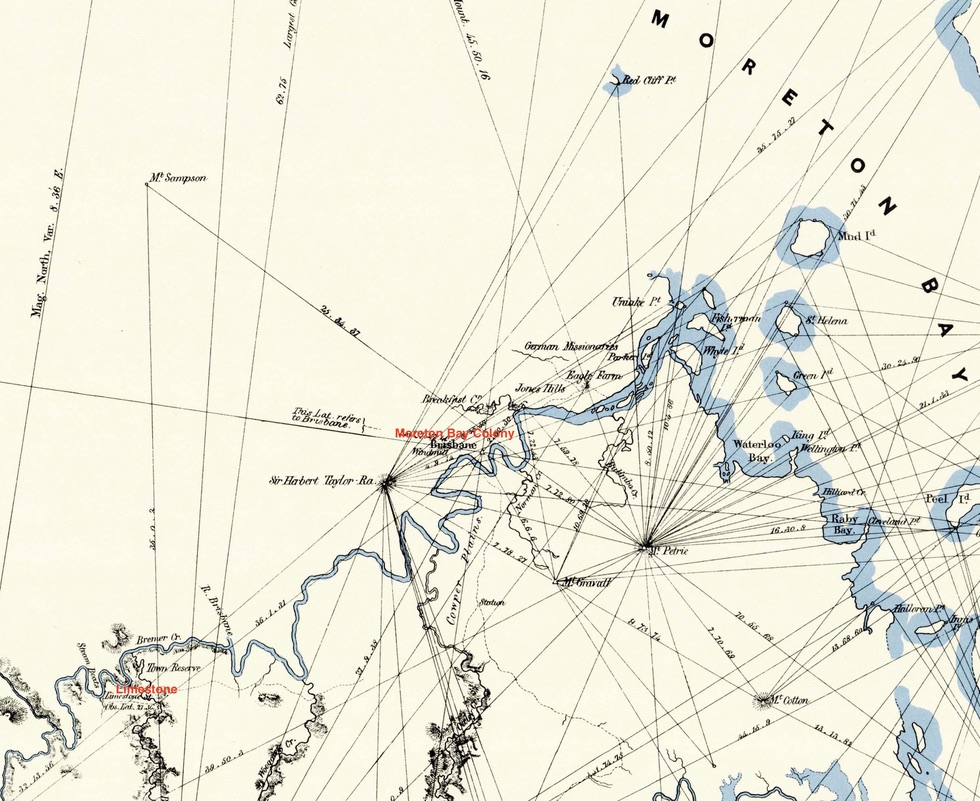
The river was all important. In Dixon’s 1840 map, the Brisbane-Bremer River systems appear as an umbilical cord connecting Ipswich and Moreton Bay and the markets beyond. Punts were quickly replaced by river steamers that worked the river, as shown below. The steamers in turn provided a ready market for the coal that recently had begun to be mined in Ipswich.
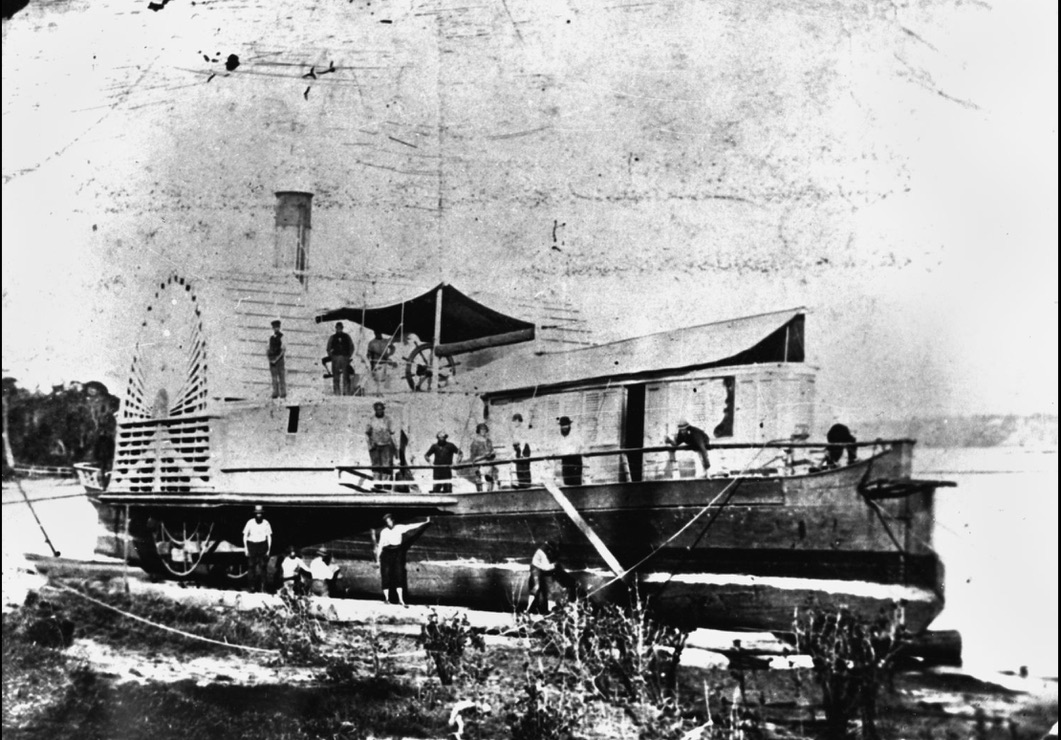
By 1843 the squatters had a problem. There were many fattened sheep and cattle, but the NSW drought meant driving them to market wasn’t an option. Ipswich was well placed to provide services like fellmongering, removing wool from dead sheep, boiling down establishments, that boil down sheep and cattle to make tallow, as well as meat processing works. Tinker Campbell set up a meat curing and boiling down works at Kangaroo Point Brisbane, but lack of labour and location had him relocate to Redbank as described in Campbells, 1875 Early Settlement of Queensland and other articles.
As described by Jarrott, in Pins, Petticoats and Ploughs (1998), Benjamin Cribb arrived in 1849, with a suitcase of goods and set up London stores, soon to become Cribb and Foote department store that would last 120 years. Cribb and Foote would be a player in Ipswich’s cotton industry, and in founding the woollen mill.
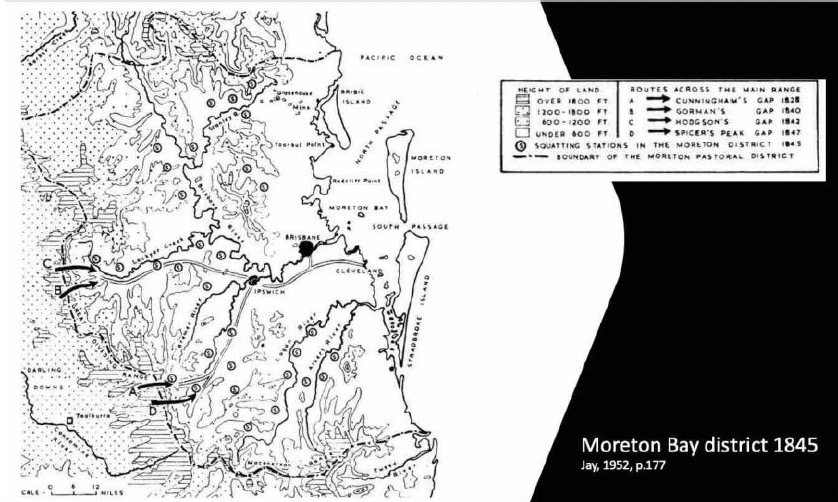
More routes were found connecting the Darling Downs to Ipswich, and the rich farming lands at the base of the ranges. More squatters and pastoral runs followed. The local Aboriginal people were displaced, and their way of life permanently disrupted. By 1845 the pastoral runs had proliferated both on the downs and surrounding Ipswich – the map above, by Jay (1952) depicts this proliferation. The heady mix of ingredients for Ipswich was primed. Geography had located it as an inland port for the pastoral lands of the Darling Downs and beyond. The river steamers plied the river, fuelled by local collieries, transporting goods – and people.
The 1850s saw early industries, beyond coal and sawmills, start in Ipswich. Smith’s Town Marie and Flemming’s Bremer Mills were industrial villages with residents working and living on these estates and having access to schools. Services were provided to pastoralist in terms of boiling down works, meat curing and fell-mongering. Sawmills, ceramics and brickworks served the needs of locals. Fleming even traded wood for wheat to mill flour.
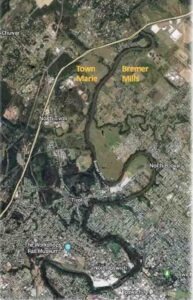
The location of these towns are indicated on the Google map below – further details can be found at Ken Grubb’s Town Marie site.
According to Campbell, “Few men in Queensland have contributed more to its early settlement than Joseph Flemming, Esq. – a member of the first parliament, and at that time, one of the largest employers of labor and capital in it.”
The river though asserted its presence, through major floors of 1857 damaging the industrial estates. They never quite recovered. According to Grubb, James Ivory bought the Town Marie and Bremer Mills estates in the 1860s. It is always a fragile truce between Ipswich residents and the Bremer River as the graph below shows. Major floods occurred frequently.

Separation anxiety
Any leaving is fraught
Severed threads fray
In an effort to find connections with the new
Separation of Queensland from New South Wales in 1859 had found fertile ground in various quarters. The loss of convict labour brought severe labour shortages. According to Gill (1989), Hodgson on the Darling Downs was vocal in vocal his call to bring back transportation and convict labour. This desire fell away as more labour became available; however, he and others maintain the push for separation. The sheer distance from Sydney was a major pull.
By the time of separation Ipswich’s population was second only to Brisbane. Ipswich missed out on the prize of being Queensland’s capital, leaving it with a new identity to forge … Queensland being a separated colony, and Ipswich the second largest town, changed everything. Ipswich became a Municipality in 1860 and the company seal was designed. The Jubilee History of Ipswich sets this out.
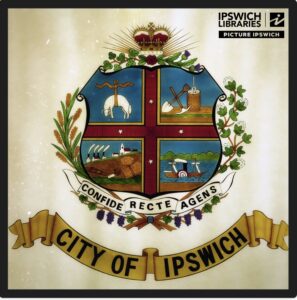
Visible in the seal are sheep, mining, and riverboats. Cotton is featured too – a new hope for the city. Industry was also featured. I wonder if it was more aspirational than reality at that point, but manufacturing was about to become Ipswich’s future. Two years later work began on the Railway workshops and building of Queensland’s first railway line to Toowoomba commenced, with the opening of the first stage to Grandchester station in 1865.The workshops brought prosperity and jobs to Ipswich. The first railway workshops were built next to the Bremer near around where Riverlink is now. Queensland Railways first Half Century and Behind the Tin Fence: A history of Ipswich Railway Workshops tell of this history.
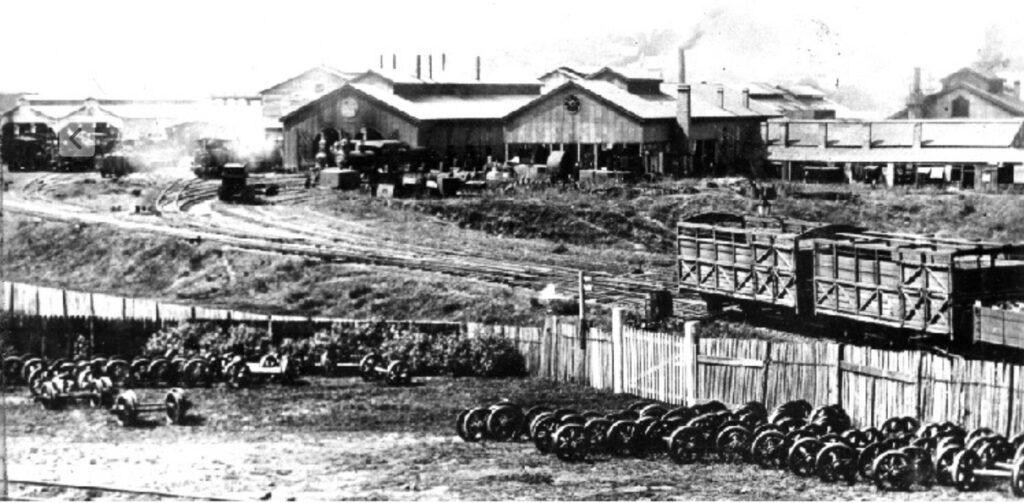
The local cotton industry got a boost at the same time. Various farmers had experimented with cotton growing since the 1840s, but they were unable to compete with the US slave grown cotton. American civil war running from 1861 to 1865, cut supplies to cotton mills in England. It was a huge opportunity, and Queensland farmers were encouraged by JD Lang to grow cotton.
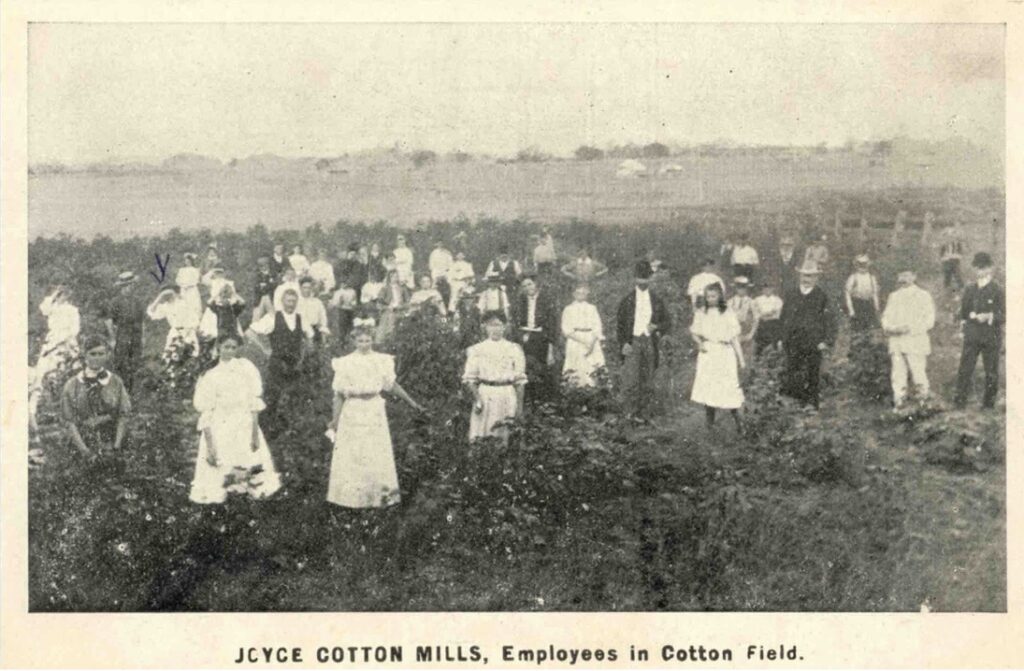
Jarrott provides details of the cotton industry, summarised in the following. In 1861 Ipswich Cotton Company in Booval set up. Its focus was growing cotton and was mainly influenced by J.D. Panton. Two years later,1863, Cribb and Foote became involved, shipping 12 bales of cotton. In 1866 the Queensland Government encouraged cotton growing and ginning for 3 years awarding a generous 10-pound bonus per bale (cleaned when shipped to England). However, prices started falling as US came back into production. In 1866, Cribb and Foote established a cotton gin in Bremer Street, their main rival was J&G Harris, and Mr Challinor at Yamanto was also setting up a cotton gin. Cribb and Foote started shipping both wool and cotton to England. Both Harris and Cribb suffered fires in their ginning mills and had to rebuild.15 In 1869 the government cotton bonus was halved, and halved again in 1870 finally ceasing in 1871. That year, Cribb and Foote shipped 2944 bales to England out of the 8507 bales that Queensland shipped. Benjamin Cribb died 1874 and was succeeded by his son Thomas Cribb but his wife Clarissa was the senior partner.
The Queensland Times, looking back on this period declared ‘Cotton was once a staple item of production in this district and did more than anything else to induce settlement of agricultural population’. Cribb & Foote continued to gin cotton until 1892, and discontinued purchasing cotton 1897. The machinery also extracted oil from the seed. Steam powered their cotton gins.
The cotton industry never quite delivered on its promise. The eventual cotton mill built in the 1890s, was short lived, although eventually provided useful infrastructure for a second woollen mill. However, in the mid 1870’s, a woollen mill was firmly on the agenda for Ipswich. The video clips pick up the beginnings of Ipswich’s woollen manufacturing story, and tell of what it took to open the doors of Ipswich’s first woollen mill.
References
Australian Bureau of Meteorology (2017) Bremer River Flood Statistics
Australian Bureau of Statistics (1861,1864,1868,1871,1876,1881, 1886, 1901) Census of the Colony of Queensland, Canberra: Commonwealth Government
Campbell, J. (1875). The early Settlement of Queensland. In. Queensland: Ipswich Observer.
Foote, A. T. (2013). Footprints in Ipswich History: An historical outline of the life of Arthur Foote, his family and the Ipswich joinery. Rev. A. T. Foote.
Gill, J. C. H. (1989). Arthur Hodgson: The centaur who left his sheep. Royal Historical Society of Queensland Journal, XIV (2).
Grubb, K. (2018). Richard Joseph Smith and Town Marie. Retrieved 12.6.2022, from Grubb https://www.townmarie.com
Harrison, G. (1960). Jubilee History of Ipswich: A record of Municipal, Industrial and Social Progress. H.J. Diddams & Co.
Harry Gentle Centre. (2017). Queensland Timeline pre-1960s – 1859. Retrieved 7.6.2021, from https://harrygentle.griffith.edu.au/wp-content/uploads/2017/11/Queensland-Timeline-pre1600s-1859.pdf
Ipswich City Council. (2017). Ipswich Historical Markers Database
Ipswich City Council. (2019a). History of the Bremer Mills. Ipswich City Council.
Ipswich City Council. (2019b). Ipswich History Timeline. Retrieved 7.6.2021, from Ipswich City Council. (n.d.).
Coal Mining Then and Now. Retrieved 7.6.2021, fromCouncilhttps://www.ipswich.qld.gov.au › search › assets › mining Ipswich Library. (2021). Janis Hanley 2022 Page 11
Early Settler Database. In: Picture Ipswich.
Jarrott, K. (1998). Pins, Petticoats and Ploughs: Cribb and Foote, universal providers to Ipswich and district from 1849 to 1977. J. K Jarrott.
Jay, L. J. (1952). The Origins and Early Growth of Brisbane, Queensland. Geography, 37(3), 166-178.
Jen, T. (n.d.). Transcriptions of James Ivory 1863-1870. Ipswich City Council.
Macno, V., Mate, G., & Mewes, D. (Eds.). (2011). Behind the Tin Fence: A history of Ipswich Railway Workshops. Queensland Museum.
Meteorology, B. o. (2017). Known Floods in Brisbane and Bremer River Basin. Retrieved 11/6/2022, from http://www.bom.gov.au/qld/flood/fld_history/brisbane_history
Morgan, A. (1902). The Darling Downs. Queensland Country Life, Dec 1902.
Queensland Government. (2016). Queensland Heritage Register. Brisbane: Queensland Government Retrieved from https://apps.des.qld.gov.au/heritage-register/detail/?id=600033
Railways, Q. (n.d.). Queensland Railways first Half Century. Queensland Railways.
Satterthwait, L. (1992). Ipswich Heritage Study Volume 1. I. C. Council.
Slaughter, L. E. (1960). Ipswich Municipal Centenary. Ipswich City Council.
Thorn, R. (2017). George Thorn: “The Father of Ipswich”: A Life. Richard Thorn.
Collections and Archives accessed in ‘Origin threads’
– Qld State Archive
– State Library of Qld
– Picture Ipswich
– Ipswich Historical Society
– State Library of South Australia
– City of Parramatta
– Blue Mountains Library
– Royal Historical Society of Victoria
– Libraries Tasmania
– Queensland Rail/Queensland Museum Network collection
Janis presented a talk at the Queensland State Archive, in June 2023, speaking about the Origin Threads project, and the colonial beginnings of Queensland’s Woollen Textile Industry.
You can watch the recording below …

